by The History Chicks | Mar 4, 2014
This excursion had us traveling away from the podcast mic to a seat in front of a camera.
We had the honor of spending a bit of time as historical consultants for the Biography Channel this past year. We made our maiden voyage to the A&E offices and studios in New York, sat down in front of camera and told the tales of some of history’s most interesting people. The result of that work is the mini-biographies listed below. We really enjoyed doing this, hope that we get the opportunity again and want to give a big, “thank you” to Producer Caitlin Van Mol for bringing us not only to New York but also onto these videos.

So, if you ever want to SEE us talking about historical figures, here is your first chance (and not just women, we can chat about the roosters, too). (The links below will lead you to the bio.com website biographies in another window. The videos play at the top, load times vary.)
Elizabeth I
Henry VIII
Henry VIII and Catherine of Aragon
Louis XIV
Marie Antoinette
Marie Antoinette and the Affair of the Diamond Necklace
Marie Antoinette and the Petit Trianon
Nefertiti
The Palace of Versailles
by The History Chicks | Dec 21, 2011 | Biography Episode, Episode, Podcasts
We attempt to be as PG13 as possible during this episode’s discussion of a woman who won the favor of a King, and is remembered as one of the most influential mistresses France has ever seen.
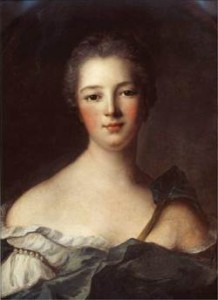
But before she could hold such a lofty position, Madame de Pompadour was a fair maiden with an interesting family. Jeanne Antoinette Poisson was born December 29, 1721 to Madeleine de La Motte and Francois Poisson. Or maybe to Madeleine and Paris de Montmartel. Or maybe Madeleine and le Normant de Tournehem. Ah, yes, Mama got around. But Francois was her husband and the father of record , so we shall call him,Papa. Tournehem was a very important part of Jeanne Antoinette’s life, so we shall call him, Uncle. And de Montmartel? He doesn’t show up much in our tale, so we don’t call him anything (although he was, technically, her Godfather.)
We discuss the education of this young woman. What was life like in this time for a child of a not titled, but wealthy family? We also discuss various versions of her early years that are floating around. How long did she study with the Urseline’s just outside of Paris? How much influence did her father have in her life? Did she really visit a fortune teller at the age of nine and what did that woman say?
But this we know: Thanks to a number of people, she got a very fine education despite Papa being sent to Germany for ten years for a financial scheme gone very wrong, and Mama losing most of their fortune in his absence. Hey! She was pulling single mom duty for not only young Jeanne Antoinette but also a younger son, Abel. She did the best she could given her circumstances, connections and, er, talents. Jeanne Antoinette was raised to be a delightful, well spoken, dignified, entertaining and educated young woman who charmed with a beauty from within. Not too shabby for growing up Kardas…Poisson.
Eventually Papa returns to Paris, Mama decorates a new beautiful home, and our girl Jeanne Antoinette is married to the nephew of potential daddy, Le Normant de Tournehem. All is well, although Jeanne Antoinette has set her sights a liiiittle higher than her husband, the father of her child. She wants the King.
And by “wants” we mean…claim his heart and serve France at court.
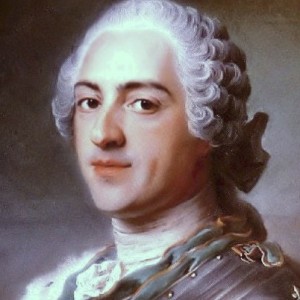
This is the King she has her sights on. Louis XV
Snares him she does. We go into the juicy details, but basically he just so happened to have an opening for a Maitress en Titre ( the chief mistress to the king), and Jeanne Antoinette (although married…and with a child) is the woman for the job! But she needed a title. He gets his people on it, finds one that wasn’t being used, and voila! Marquis de Pompadour. A little training in life at Versailles, a presentation to court and she moves into the palace and gets to work. Such as it is.
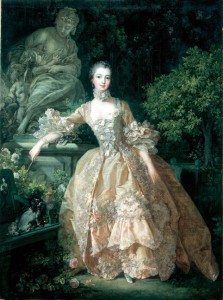
by Francois Boucher
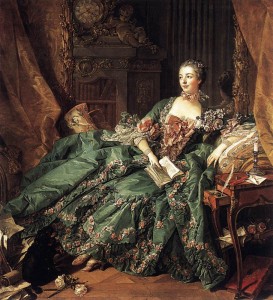
Hard at work (Boucher)
For the next twenty years she is at the King’s side. Oh, yes, he had a Queen….but Madame de Pompadour understood and inspired the King like no other woman in his history. He listened to her on matters of state, of design, of art, of leisure, of just about anything that he was involved in- so was she. Sometimes the endeavors were successful, sometimes notsomuch.
We try to not get too bogged down with the wars and the politics, but those were just two of the things that Mme de Pompadour’s opinion was sought by Louis. We do name drop a little during the podcast, seriously, when the woman’s bestie is Voltaire, you KNOW there are going to be some A list parties!
She suffers sadness, uncertainty, a lot of bad press, a loss of sexual abilities but maintains a close, deep friendship and love with Louis for the remainder of her days. In 1764, at the age of 42, she dies in Versailles (which was forbidden, btw) of either lung cancer or tuberculosis.
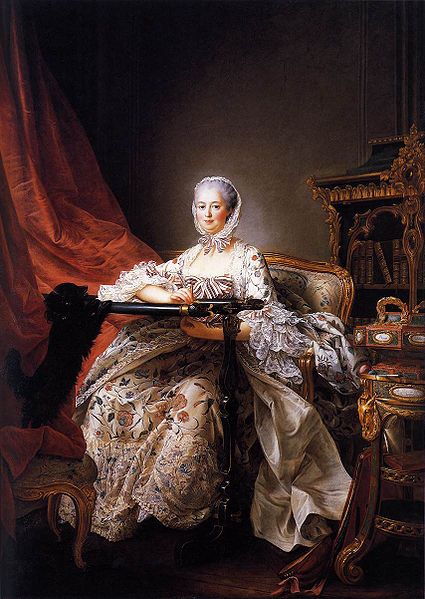
Final portrait begun just days before death, finished after it (by Francois Hubert Drouais)
Time Travel With The History Chicks
As always, there is so much more to the life of this woman than we can cover in an hourish. If you are intrigued, we suggest your first stop should be over to Madamedepompadour.com (There really is a dotcom for everything, isn’t there?) Lots and lots of info and links to get you cruising along.
If you are as fascinated with Versailles as we are, or even just a little, here is a direct link to purchase the book we told you to get waaay back when we talked about Marie Antoinette: Versailles, A Biography Of A Palace, by Tony Spawforth. Get it now, you are going to want it. (And, we do not get paid by Amazon, or anyone else that we recommend in this section, but that’s how much we want you to have this book!)
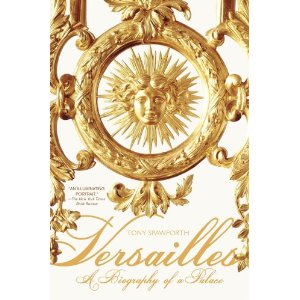
Get this book.
Not Mme de Pompadour specific, but we also would recommend The Bourbons: A History of a Dynasty by J.H. Shennan

Want some historical fiction to go with your newfound Mme de Pompadour knowledge? The book Beckett recommended is To Dance with Kings, by Rosalind Laker; the book that Susan’s friend Melissa recommended is The Philosopher’s Kiss by Peter Prange.
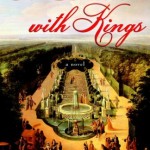

Here is a link that we promised to l’ecole Royale Militaire, the military school begun by Louis XV, ( with the encouragement of Mme de Pompadour, of course). L’ecole Militaire.
And finally, what discussion of Madame de Pompadour would not be complete without a TARDIS?

We are not endorsing this product. We don't have one, don't know if it works well, know nothing about it other than...how cool is that?!
Get it here, and tell us if it’s as cool as it looks. Seriously though, Mme Pompadour appeared in the Dr Who storyline…read all about it here.
As always, music comes courtesy of Music Alley. Visit them at Music.mevio.com
by The History Chicks | Jul 18, 2011 | Shownotes
When we started this project we decided that a season would consist of ten full- length episodes, posted approximately two weeks apart, with an option of unlimited mini episodes to allow for spontaneity. We also decided that we would end the season with a series near and dear to our hearts. We thought this would give us some structure, and a goal, as well as the freedom to deviate if we wanted to chat a little bit about someone- or something- related to the subject of the full episode.
We had a plan. And, for the most part, we stuck to it. Marie Antoinette, Laura Ingalls Wilder, Cinderella Abigail Adams, Dolley Madison, Lizzie Borden, Helen Keller, The Mrs. Astor, Gilded Age Heiresses and Jennie Jerome Churchill. We supplemented those episodes with mini-conversations: Abigail Adams and Feminism, Books in the Little House Series, Little Red Riding Hood, Anne Sullivan Macy, The Age of Innocence movie, and Gilded Age Servants.
And we have big plans for next season as well. Oh yes, we do! But we will be taking a short break from posting full length episodes so we can get ready for that season. And have some summer fun with our families that does not include midnight editing and writing sessions, child care juggling to ensure quiet while recording, and rushing to bring back long overdue library books.
But, just as we had a plan for Season One, we have a plan for this hiatus and you will barely know we are gone. We will be putting out some postcard type entries when we stumble across (on purpose) things we know you might like. And we will be monitoring both our website, facebook page, google+ and twitter (although, we admit, we are not the best tweeters out there. We’ll own that and work on it).
This episode is a question and answer grab bag. We posted a call for questions which we answer in this episode, as well as some odds and ends we thought would be fun. We tell you a bit about National Novel Writing Month, about how we met, how we worked, and some other questions that listeners asked us. First off here is the link to NaNoWriMo- http://www.nanowrimo.org/. (Which has nothing to do with history except our own.)
Here is our solemn vow ( in print!): When we hit 1000 likes on facebook we will have a Tudors series.
Listen to the podcast for more info…but we know how much you like your visuals. And we get asked this question A LOT:
What do you look like?
Can’t we show you where we record instead, it’s so much more interesting…
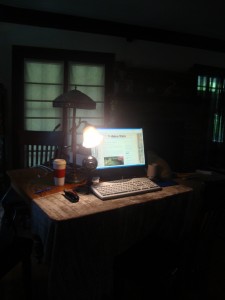
This is where we sit when we talk. It might explain a lot.
Ok…we snapped some pics and this is our favorite image of us. Totally shows you who we are and what we look like:
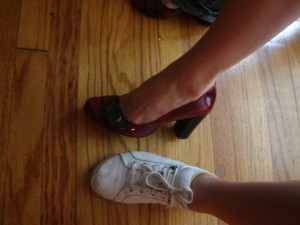
Beckett wore cute shoes that day, Susan went for comfort. Actually, Beckett always wears cute shoes and Susan always goes for comfort. And we have the same size feet. True.
Oh! You want to know what our FACES look like! Got it…

Susan- action shot.
Yeah, we could do this all day.
Thank you for your encouragement,and emails and notes to us! Thank you for telling us who you would like to hear us discuss, and thank you for telling us where you listen to us. Thank you for clicking our stylish DONATE button, and for writing such wonderful reviews for us on iTunes. Thank you for listening! We are having a wonderful time and are very excited to come back to you very soon with Season Two!
Peace!
Beckett and Susan
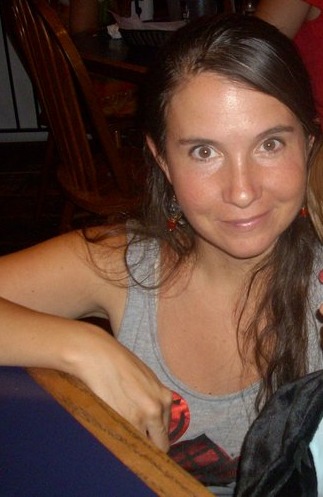
I should have used my "fairy pixie" shot. Maybe next season... Beckett

You could have just googled to see this. Susan
by The History Chicks | Mar 27, 2011
1. The Lansdowne Portrait
This is the famous painting that Dolley Madison helped to save from the British during their invasion of Washington, DC in 1814!
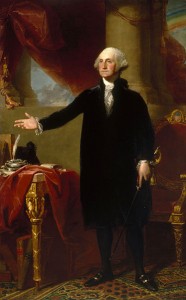
No small feat – this painting is 5×8 – the size of most dining room tables!
Senator William Bingham (perhaps the wealthiest man in the country) commissioned this iconic painting from the portraitist Gilbert Stuart in 1796. It depicts George Washington at the end of his two terms as president, as he prepares to cede power to his successor. Though not written into law, George Washington’s voluntary two-term limit became a custom that held until the election of Franklin Roosevelt for a thrid term in 1940!
The portrait was given as a gift to The Marquess of Lansdowne (known during this period as William Petty, the Earl of Shelburne) to thank him for his support of the American cause within the British Parliament.
The Earl (mostly against party lines, and in his own self-interest) worked tirelessly to promote the free trade between the United States and Britain, putting forth legislation that would treat the United States like any other sovereign country.
Senator Bingham, who had amassed his huge fortune largely by privateering and legitimate trade, benefited greatly from this advocacy. A long-distance friendship of sorts had sprung up from all of their correspondence about trade issues. Shelburne rose high in the British government, becoming the Prime Minister for the last months of the American Revolution.
I’m not sure I would love for someone to give me an unsolicted gift the size of an area rug, but I can certainly appreciate the sentiment behind it. This painting stayed in Europe until 1965, when it was sent on anonymous loan to the Smithsonian.
Stuart was paid a thousand dollars for his work on this painting. In 2001, the Reynolds Foundation bought it for $30 million dollars as a gift to the nation. It now resides in the National Portrait Gallery at the Smithsonian, with copies in the White House, the US House of Representatives, and several other government buildings throughout the nation.
For a discussion on the symbolism in this portrait, please visit the interactive page at the Smithsonian Portrait Gallery at http://www.georgewashington.si.edu/portrait/index.html
*********************************
2. The Epergne
Dolley Madison was not only famous for her “squeezers” – her popular, well-attended balls in which everyone got about 10 inches of floor space. She also gave lavish dinners, which were carefully balanced between the refined elegance of a European court and the abundant offerings of the New World.
One element that was sure to be at the center of every fashionable dining table of the time was a silver epergne (Pronounced ay-PERN).
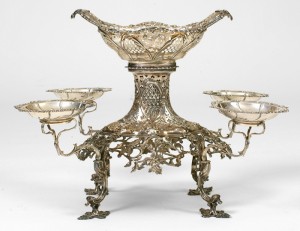
If you have a spare 18K, this Georgian Epergne could be yours!
The top bowl was often filled with decorative fruits (and in later times, flowers), and the lower vessels held candied fruit, nuts, or small confections. The piece, loaded with tempting goodies, stood intact as a decorative centerpiece through all of the courses of a formal dinner, then guests helped themselves from it during the dessert course. (If there had been a tablecloth during the meal, the epergne was removed with the cloth, then replaced on the bare table for the dessert course.)
What are the origins of the epergne? During the 1600s, one would find a surtout in the middle of the table – simply a large tray which held and displayed the expensive spices and condiments to accompany a meal. The assorted height and materials of the containers lent a decorative element. The fruitier, a tiered display stand introduced later, more closely resembled the epergne. The fruitier would take the place of the surtout towards the end of each meal.

The fruitier served the same decorative function as these (later) fruit stands.
The epergne came into being around 1735, and most early examples were produced in the Rococo style, which used curved “shell” motifs. (think Marie Antoinette’s bedroom, for one example.) The mid-17th century fascination for Chinoiserie led to the inclusion of pagoda-like shapes and bells. (The example shown below is less than a mile from my house right now!)
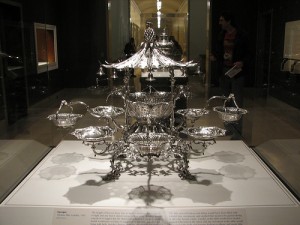
Note the fabulous bells! This epergne is from approximately 1761.
By the time Dolley Madison was hosting her dinner parties, the epergne was a standard element of the well-appointed table…
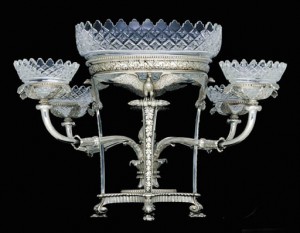
The very latest fashion at the time Dolley Madison was holding court in the White House. This piece, circa 1810.
Though not everyone was enchanted with them. They were hard to see around, for one thing. The larger and more obtrusive they were, the less you could speak to the people in your party. From the book Foul Play, by Charles Reade (1869!)
“But their tongues were tied for the present; in the first place, there stood in the middle of the table an epergne, the size of a Putney laurel-tree;
neither Wardlaw could well see the other, without craning out his neck like a rifleman from behind his tree… “
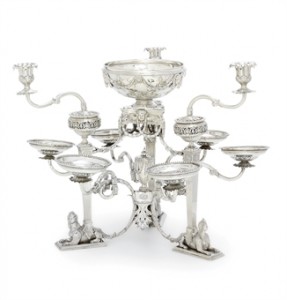
- Once this was loaded up, good luck seeing the other side of the table! Circa 1771, candelabra added approx. 1838.
And does anyone remember the great lump in the middle of the table in Dickens’ “Great Expectations”?
“An epergne or centrepiece of some kind was in the middle of this cloth; it was so heavily overhung with cobwebs that its form was quite undistinguishable; and, as I looked along the yellow expanse out of which I remember its seeming to grow, like a black fungus, I saw speckled-legged spiders with blotchy bodies running home to it, and running out from it, as if some circumstances of the greatest public importance had just transpired in the spider community.”
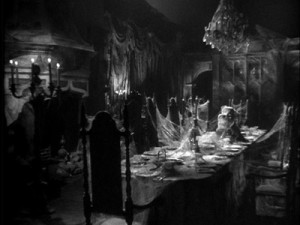
- Of course, it was not an epergne at all, but her wedding cake, left to moulder for years and years. Yummy!
Modern-day historical romance writer Catherine Coulter refers to an “Ugly Epergne” in three of her books: The Nightingale Legacy (1995), The Wild Baron (1997) and The Countess (1999).
And the oddest Epergne story of all: Writer Dante Rossetti has a series of pet wombats, one of whom would commonly (and famously) sleep in the epergne during dinner parties!
” On grand occasions when a number of guests were invited to dinner, Dante Gabriel was in the habit of using the so-called drawing room on the first floor as a dining room. It was a large room with a good view out over the river. On the table in the centre of the room was a large epergne. Into this receptacle Dante Gabriel used apparently to place the somnolent wombat and there it would normally remain fast asleep until lifted down after the guests had gone. James Mc Neill Whistler told a particularly good story about one of these dinners. Among the guests were Meredith, who was talking brilliantly, and Swinburne, who was reading aloud from Leaves of Grass. The wombat was in the epergne and conversation flowed freely. However, the target of Meredith’s wit that night was Rossetti. As some of his patrons were present, Rossetti became embarrassed and eventually very cross. ‘The evening ended less amiably than it had begun, and no one thought of the wombat until a late hour, and then it had disappeared.’ A great search was instituted, but to no avail. Months passed until one day Rossetti sought his cigars for a guest. ‘Not a cigar was left but there was the skeleton of the wombat.”
At the turn of the present century, (and out of our period) the epergne turned from the display of food towards the arrangement of flowers. Trumpets of colored glass on tiered stands became the norm. Let me leave you with a picture of one of my favorites:
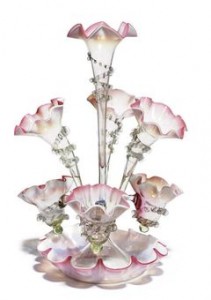
Beautiful glass epergne from 1891, meant to hold flowers. We love it empty!
by The History Chicks | Feb 23, 2011
Ancestors of Cinderella’s Castle – Part I- The Loire Valley
We all know the iconic Cinderella castle at Disney World (and its companion Sleeping Beauty Castle in Disneyland). It’s the most recognizable Disney icon after Mickey Mouse! Chief designer Herbert Ryman based his designs for these princessworthy castles on several real ones throughout Europe.
1.Chenonceau – “The Women’s Castle” (1521)
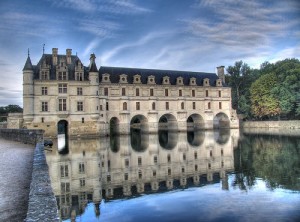
It’s now owned by chocolate magnates.
The original owner, Thomas Bohier, bought the site of an old mill and set about converting it into a grand residence. Since he was largely absent from home due to his work, it fell to his wife, Katherine, to supervise and design the chateau. She added numerous towers to use as bathrooms and storage, a shockingly innovative straight staircase (rather than a circular one, as was traditional), and an interior hallway from which rooms opened, rather than room after room simply leading into each other. King Francis I lost no time in seizing this chateau for the crown as soon as the family fell into financial difficulties.
Diane de Poitiers (mistress of Henri II) was given the chateau later in the century, and began work on the arches spanning the river Cher, still the chateau’s most famous feature.
Catherine de Médicis (wife of Henri II), evicted Diane (go, wives!) and compelled her to trade this Château in return for Chaumont (a lesser residence). The distinctive arches were completed during Catherine’s tenure as chatelaine.
Mary, Queen of Scots, child bride of François II, also spent one spring and summer here after her husband’s early death.
Louise of Lorraine, the wife of Henry III, inherited Chenonceau upon the death of the queen mother in 1587. Upon her husband’s death, she wore only white (the color of royal mourning) gave her fortune to charity, and painted her bedroom black, covering the walls with feathers, bones, and silver gravedigger’s instruments. After her death, it remained empty for over a hundred years.
Voltaire, Montesquieu and Rousseau all frequented the chateau during its restoration in 1733, while it was owned by Madame Dupin, hostess of famed salons where artists, authors, philosophers, and the nobility met to discuss intellectual and spiritual matters. She saved the chateau from certain destruction during the French Revolution by allowing full access to the chateau to all people, as it was the only bridge across the River Cher.
During WWII, the castle’s main entrance was on occupied territory, and the south entrance was in the free zone. The French Resistance made good use of this situation!
*********************************
2. Chambord (Begun 1519, never finished)
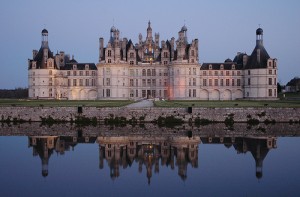
The middle section’s roofline was the inspiration for the castle in Beauty and the Beast.
Francis I, future seizer of Chenonceau (see above), brought Leonardo da Vinci to France for three years to work on an unrelated castle project. It is highly likely that that Da Vinci also completed the plans for Chambord during this period before he died in 1519.
The château was built as a hunting lodge for the king (like the much-later Versailles – what is it with these kings and their extravagant hunting lodges?). Since it was never intended to act as a true fortress, most of the “defensive” elements of a normal castle – the moat, towers, and limestone-facaded walls, are purely decorative. Sounds a little like Cinderella’s castle already!
Francis’ great aim in building this frivolous castle was to impress his rivals, Henry VIII of England and Charles V, Holy Roman Emperor. The grand scheme included the conceit that he wanted the roofline to resemble the skyline of the city of Constantinople. This very roofline, taken out of context from the chateau pictured above, was used as the inspiration for another Disney castle, The Beast’s castle from Beauty and the Beast. The famous staircase through the center of the building is a double-helix spiral (A fact some point to in order to bolster the claims of Da Vinci’s involvement in the architecture.)
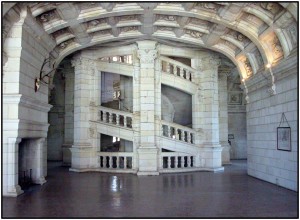
Two people could travel around at the same time without ever meeting each other.
After all the thought, trouble, and expense poured into Chambord, the king and his 2000 person entourage spent a total of about 70 days here during his entire reign. The castle was not practical for permanent residency – it was cold and unheatable despite the nearly 400 fireplaces – and everything from wall tapestries to kitchen equipment to the very beds everyone slept in had to be carried to and from for each separate visit. This situation was relatively common – most furniture of the time was designed to be knocked down for transportation. However, what WAS unusual was that this castle was not situated near a village or estate to provide supplies. Each and every item or person required had to come a great distance, save the game caught during hunting excursions. Very rarely did a visit here last over just a few days.
Work continued on the castle sporadically until the reign of Louis XIV (Marie Antoinette’s “Grandpa King”). His grand addition was a stable that could accommodate 1200 horses. Poor local wildlife! They didn’t stand a chance!
The castle came near to being demolished during the French Revolution – and in 1793, anything moveable here was sold or otherwise disposed of.
In the period immediately preceding WWII, the government evacuated the collections of the Louvre and the Compiègne to Chambord for safekeeping – including the famous damsels the Mona Lisa and the Venus De Milo! Though saved from the German onslaught, they had a close call whan an American B-24 bomber crashed on the grounds in 1944.
*********************************
3. An Important number for Further Reading
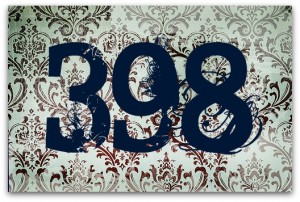
You’ll be shocked at the number of shelves this occupies!
This is the Dewey Decimal System’s classification for “folklore.” So what is folklore, exactly?
Folklore is the legends, popular beliefs, fairy tales, customs, and oral histories that are the traditions of a culture. It can also refer to the ways within a culture that these ideas are transmitted (such as music, artifacts, and rituals.)
Take yourself into the children’s section for this project… Often, as in my local branch, librarians will segregate this entire classification, since there are so many titles within it that they warrant a whole wall of shelving! You’ll be amazed at what you might find… for example, over thirty Cinderellas (398.2, as I recall) caught my eye before I lost count!
Then, if you like, cruise back through the grown-up section of the library, using the same number, for some analysis and historical works of a more serious nature.
Have fun!!
*********************************
Chaumont (finished 1475) and Jacques Donatien Le Ray de Chaumont
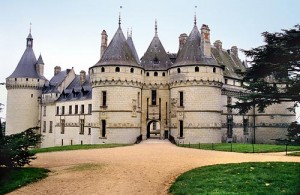
Its seizure was an unintended consequence of the American Revolution.
This strategic location, home to fortifications since the 10th century, became the home of the Chateau de Chaumont in 1475. More of a fortress than the previous chateaux due to its earlier construction, the fourth wall of this castle was taken down to improve its view of the valley in 1750.
One of this castle’s owners has strong ties to the American Revolution! Jacques Donatien Le Ray was widely considered by the newborn United States to have been the French “father of the American Revolution.”
Le Ray, no aristocrat, had made enormous fortunes in shipping, and became widely respected for his daring and business acumen. Louis XVI (Marie Antoinette’s husband) appointed Jacques a member of his council and he quickly became one of the king’s chief advisors in commercial matters.
After the signing of the Declaration of Independence, emissaries (including including such notables as Benjamin Franklin, John Adams, and the Marquis de Lafayette) were sent to France to seek assistance from King Louis XVI. Le Ray acted as an advocate for their cause, ultimately playing a large role in the critical French decision to become involved on the American side of the war. America would not have won the Revolutionary War without France’s financial and military aid.
Benjamin Franklin is often credited with obtaining that critical aid from the French king. However, it was Le Ray who funneled huge amounts of cash his way, enabling Franklin to purchase weapons, clothing, and supplies. Le Ray commissioned the construction of the warship “USS Bonhomme Richard” (An homage to Benjamin Franklin’s pen name, “Poor Richard”) at his own expense, and gave it to the Americans to assist in the fight.
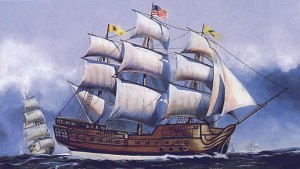
The USS Bonhomme Richard -given to the US by a sympathetic Frenchman.
He championed the cause of the American Revolution, believing strongly in the equality of men and the resistance to the tyranny of the British government. (Though, curiously, he was against the French Revolution. A classic case of “not in my backyard?” Perhaps.)
The political ideals of liberty and equality of all men that Jacques has espoused turned against him (and the king and queen, famously.) The massive financial aid that he had helped convince King Louis XVI to supply led to the bankruptcy of the French government. To compound the matter, drought caused a severe famine in France and the French Treasury had no more money available to subsidize the cost of flour for bread to prevent thousands of people from starving.
In 1789, in a semi-ironic twist of fate, the French Revolutionary government seized the Chateau Chaumont.
































